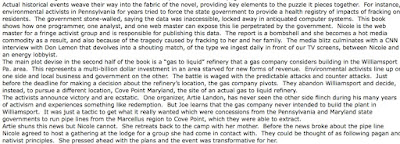Your query letter should NOT include large blocks of text in italic.
Your query letter should NOT have anything decorative in it, like this pretty blue stripe. (Watch for "image.gif" as an attachment, when you're not sending attachments.) TEST your email on a different computer if you're not sure if this is happening.
Your query letter should NOT be a big bloc O'Text.
Break up paragraphs into 3 or 4 lines, then add a blank line to create white space.
Big blocs o'text are almost impossible to read. Making your query harder to read is
not a good idea.



5 comments:
Gmail has an option at the end of the formatting bar for "Remove formatting." I am a BIG fan of this. When assembling a query email I'd be pulling from 2-3 different documents (query, pages, synopsis) that each had their own formatting, plus the default Gmail formatting. But with one button, it's all standardized. It even handles putting in the spaces between paragraphs. You do have to go back in and add any formatting later (I very quickly memorized the italics in my first ten pages) but it's a small price to pay for an email that looks tidy and professional every time.
All three of those examples just hurt my eyes.
You can always create a version of your query and pages in Notepad (or whatever the Mac equivalent is) and use that to copy-paste into email. That should help reduce (or eliminate) any special formatting.
Sorry guys, the blue stripe is mine - its been there for so long I just didn't see it when sending emails... Now I see it it looks like I'm trying to make my emails into birthday cakes or something. The image. gif. thing is from the signature section in options/emails so has been deleted. I tell you what it was worth sending the Query in just to get that sorted! Otherwise who knows how many more 'pretty blue stripes' I might have sent out.
Thanks Shark
Writing, for me, is fundamentally visual and aural as well as mental. We're told often, as authors, to read the work aloud - but nobody remembers to LOOK at it from a distance, to see its literal visual balance on a page.
Though reading is most often a silent activity, we still have to hear it with our brains. Rhythm is powerful, and you can see some reflection of it in the relative sizes of your paragraphs, pages, chapters. PDF'ing a piece is a good way to look at it and ONLY look at it, to see it and not fall in some crack to fiddle details and stop seeing the whole.
Post a Comment